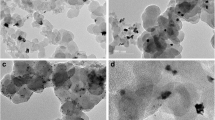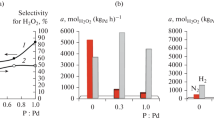Abstract.
Previous work on the electrochemistry of palladium in aqueous acid solution demonstrated the existence of two multilayer hydrous oxide reduction peaks, one at ca. 0.24 V and another at ca. 0.55 V vs. RHE, plus the presence of a reversible active surface state transition at ca. 0.24 V. In the present work with thermally activated palladium it was observed that, in agreement with the hydrous oxide reduction behaviour of the system, there is a second active state transition at E≥ca. 0.45 V. In most of its reactions in aqueous acid solution, apart from its unusual capacity to absorb hydrogen, palladium exhibits properties very similar to those of platinum; however, palladium seems to be more prone to dissolution and subsurface oxygen formation. Also the premonolayer oxidation responses of these two metals are often different as the more active state of the palladium surface is not as readily generated as that of platinum. The electrocatalytic properties of palladium, as reported earlier, correlate quite well with the hydrous oxide and premonolayer oxidation behaviour of this electrode system.
Similar content being viewed by others
Author information
Authors and Affiliations
Additional information
Electronic Publication
Rights and permissions
About this article
Cite this article
Burke, D.L., Hurley, L.M. The effect of thermal pretreatment on the electrochemical response for palladium in aqueous media. J Solid State Electrochem 7, 327–336 (2003). https://doi.org/10.1007/s10008-002-0331-2
Received:
Accepted:
Issue Date:
DOI: https://doi.org/10.1007/s10008-002-0331-2




